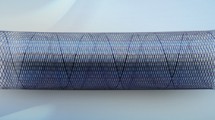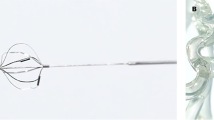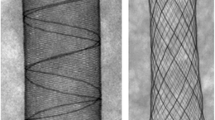Abstract
Introduction
This study aims to test a novel balloon expandable stent covered with a polytetrafluoroethylene membrane (neurovascular embolization cover (NEC), NFocus Neuromedical, Palo Alto, California) regarding angiographic and histologic aneurysm occlusion. Radiopacity, stent placement, navigation, flexibility, and intimal proliferation were also evaluated.
Methods
Eight aneurysms were induced in New Zealand white rabbits. Digital subtraction angiography (DSA) was performed directly after stent placement and after 5 and 10 min. Four and 8 weeks after stent placement, an intra-arterial DSA control was performed. The animals were then sacrificed and the aneurysms histologically evaluated.
Results
The radiopaque markers were clearly visible. Although all the stents were easily navigated into the subclavian artery, the limited flexibility of the stent resulted in straightening of the vessel in four cases. As a result, exact stent placement was achieved and acutely confirmed in only two cases. However, at sacrifice, angiographic and histologic occlusion was noted at follow-up in five aneurysms.
Conclusion
In tortuous anatomy, the relative stiffness of the stent makes exact stent placement challenging. This may have been exacerbated by the movement of the vessels due to proximity to the heart in this model. Future studies should evaluate whether existing residual flow into an aneurysm lumen might lead to embolization without any additional treatment. Anticoagulation remains a very important part of aneurysm treatment with stents. The trend toward aneurysm occlusion by excluding it from the blood circulation seems a promising method in future endovascular therapy. The NEC device shows good potential.





Similar content being viewed by others
References
Higashida RT, Smith W, Gress D et al (1997) Intravascular stent and endovascular coil placement for a ruptured fusiform aneurysm of the basilar artery. Case report and review of the literature. J Neurosurg 87:944–949
Altes TA, Cloft HJ, Short JG et al (2000) 1999 ARRS Executive Council Award. Creation of saccular aneurysms in the rabbit: a model suitable for testing endovascular devices. American Roentgen Ray Society. AJR Am J Roentgenol 174:349–354
Cloft HJ, Altes TA, Marx WF et al (1999) Endovascular creation of an in vivo bifurcation aneurysm model in rabbits. Radiology 213:223–228
Grunwald IQ, Romeike BF, Roth C, Struffert T, Eymann R, Reith W (2005) Anticoagulation regimes and their influence on the occlusion rate of aneurysms: an experimental study in rabbits. Neurosurgery 57(5):1048–1055 discussion 1048–55
Romeike BF, Feiden W (1998) Demonstration of platinum microcoils in embolized blood vessels in-situ using a modified methyl methacrylate embedding method, and a special cutting and grinding technique. Biotech Histochem 73:198–201
Grunwald IQ, Papanagiotou P, Struffert T, Politi M, Krick C, Gül G, Reith W (2007) Recanalization after endovascular treatment of intracerebral aneurysms. Neuroradiology 49(1):41–47
Turjman F, Acevedo G, Moll T, Duquensnel J, Eloy R, Sindou M (1993) Treatment of experimental carotid aneurysms by endoprosthesis implantation: preliminary report. Neurol Res 15:181–184
Geremia G, Haklin M, Brennecke L (1994) Embolization of experimentally created aneurysms with intravascular stent devices. AJNR, Am J Neuroradiol 15:1223–1231
Geremia G, Brack T, Brennecke L, Haklin M, Falte R (2000) Occlusion of experimentally created fusiform aneurysms with porous metallic stents. AJNR, Am J Neuroradiol 21:739–745
Turjma F, Massoud TF, Ji C, Guglielmi G, Vinuela F, Robert J (1994) Combined stent implantation and endosaccular coil placement for treatment of experimental wide-necked aneurysms: a feasibility study in swine. AJNR, Am J Neuroradiol 15:1087–1090
Szikora I, Geterman LR, Wells KM, Hopkins LN (1994) Combined use of stent and coils to treat experimental wide-necked carotid aneurysms; preliminary results. AJNR, Am J Neuroradiol 15:1091–1102
Wakhloo Ajay K, Schellhammer F, de Vries J, Haberstroh J, Schumacher M (1994) Self-expanding and balloon-expandable stents in the treatment of carotid aneurysms: an experimental study in a canine model. AJNR, Am J Neuroradiol 15:493–502
Redekop G, Marotta T, Weill A (2001) Treatment of traumatic aneurysms and arteriovenous fistulas of the skull base by using endovascular stents. JNS 95:412–419
Alexander MJ, Smith TP, Tucci DL (2002) Treatment of an iatrogenic petrous carotid artery pseudoaneurysm with a Symbiot covered stent: technical case report. Neurosurgery 50:658–662
Chiaradio JC, Guzman L, Padilla L, Chiaradio MP (2002) Intravascular graft stent treatment of a ruptured fusiform dissecting aneurysm of the intracranial vertebral artery: technical case report. Neurosurgery 50:213–217
Islak C, Kocer N, Albayram S, Kixikilic O, Uzma O, Cokyuksel O (2002) Bare stent graft technique: a new method of endoluminale vascular reconstruction for the treatment of giant and fusiform aneurysms. AJNR 23:1589–1595
Kocer N, Kizilkilic O, Albayram S, Adaletli S, Kantarci F, Islak C (2002) Treatment of iatrogenic internal carotid artery laceration and carotid cavernous fistula with endovascular stent graft placement. AJNR 23:442–446
Nishi S, Nakayama Y, Ueda-Ishibashi H, Matsuda T (2003) Embolization of experimental aneurysms using a heparin-loaded stent graft with micropores. Cardiovasc Radiat Med 4(1):29–33
Kallmes DF, Ding YH, Dai D et al (2007) A new endoluminal, flow-disrupting device for treatment of saccular aneurysms. Stroke 38:2346–2352
Ahlhelm F, Roth C, Kaufmann R et al (2007) Treatment of wide-necked intracranial aneurysms with a novel self-expanding two-zonal endovascular stent device. Neuroradiology 49:1023–1028
Yoshioka T, Wright KC, Wallace S, Lawrence DD, Gianturco C (1988) Self-expanding endovascular graft: an experimental study in dogs. AJR 151:673–676
Geremia G, Bakon M, Brennecke L, Haklin M, Silver B (1997) Experimental arteriovenous fistulas: treatment with silicone-covered metallic stents. AJNR 18:271–277
Link J, Feyerabend B, Graberner M, Linstedt U, Brossmann J, Thomsen H, Heller M (1996) Dacron-covered stent-grafts for percutaneous treatment of carotid aneurysms: effectiveness and biocompatibility—experimental study in swine. Radiology 200:397–340
Blasco J, Macho JM, Burrel M, Real MI, Romero M, Montana X (2004) Endovascular treatment of a giant intracranial aneurysm with a stent graft. J Vasc Interv Radiol 15:1145–1149
Saatci I, Cekirge S, Ozturk HM, Arat A, Ergungor F, Sekerci Z, Senveli E, Uygur E, Turkoglu S, Ozcan OE, Ozgen T (2004) Treatment of internal carotid artery aneurysms with a covered stent: experience in 24 patients with mid-term follow-up results. AJNR 25:1742–1749
Acknowledgment
We would like to thank the Head of Department for Diagnostic and Interventional Neuroradiology, Prof. Reith, and the Head of Department for Experimental Surgery, Prof. Menger, for supporting and accommodating this study. In addition, we want to thank Nfocus Neuromedical, Palo Alto, California for supplying us with the stents.
Conflict of interest statement
We declare that we have no conflict of interest.
Author information
Authors and Affiliations
Corresponding author
Additional information
Kühn and Roth contributed equally
Rights and permissions
About this article
Cite this article
Kühn, A.L., Roth, C., Romeike, B. et al. Treatment of elastase-induced intracranial aneurysms in New Zealand white rabbits by use of a novel neurovascular embolization stent device. Neuroradiology 56, 59–65 (2014). https://doi.org/10.1007/s00234-009-0605-9
Received:
Accepted:
Published:
Issue Date:
DOI: https://doi.org/10.1007/s00234-009-0605-9




